Beer in Belgium
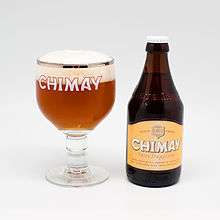
Beer in Belgium varies from pale lager to lambic beer and Flemish red. There are approximately 180 breweries in the country,[1] ranging from international giants to microbreweries.[2] In 2016, UNESCO inscribed Belgian beer culture on their list of the intangible cultural heritage of humanity,[3] noting that:[4]
beer culture in Belgium combines know-how concerning nature, social practices and craft skills that constitute an integral part of daily and festive life. Regularly shared between practitioners, knowledge and skills are transmitted from masters to apprentices in breweries but also within families, in public spaces and through formal education. Beer culture in Belgium contributes to the economic and social viability at local level and the constitution of the social identity and continuity of its bearers and practitioners, who promote responsible production and consumption.
On average, Belgians drink 84 litres of beer each year, down from around 200 each year in 1900.[5] Most beers are bought or served in bottles, rather than cans, and almost every style of beer has its own particular, uniquely shaped glass or other drinking-vessel.[6] Using the correct glass is considered to improve its flavor.
History
Brewing in Belgium dates back at least to the age of the first crusades in the 12th century. Under the Catholic Church's permission, local French and Flemish abbeys brewed and distributed beer as a fund raising method. The relatively low-alcohol beer of that time was preferred as a sanitary option to available drinking water. What are now traditional, artisanal brewing methods evolved, under abbey supervision, in the next seven centuries.
The Trappist monasteries that now brew beer in Belgium were occupied in the late 18th century primarily by monks fleeing the French Revolution. However, the first Trappist brewery in Belgium (Westmalle) did not start operation until 10 December 1836, almost fifty years after the Revolution. That beer was exclusively for the monks and is described as "dark and sweet." The first recorded sale of beer (a brown beer) was on 1 June 1861.[7]
In the 16th and 17th century, a beer termed crabbelaer was the most popular beer in Ghent;[8] at the peak of its popularity, more than 50 different breweries produced more than 6 million liters a year. Other kinds of beer brewed in Ghent were klein bier, dubbel bier, clauwaert, dubbele clauwaert and dusselaer.[9]
Trappist beers
The brewing of Trappist beers takes place in Trappist monasteries. For a beer to qualify for Trappist certification, the brewery must be in a monastery, the monks must play a role in its production and the policies and the profits from the sale must be used to support the monastery or social programs outside. Only eleven monasteries currently meet these qualifications, six of which are in Belgium, two in the Netherlands, one in Austria, one in the United States, and one in Italy. Trappist beer is a controlled term of origin: it tells where the beers come from, it is not the name of a beer style. Beyond saying they are mostly top-fermented, the Trappist beers have very little in common stylistically.
The current Belgian Trappist producers are:
- Achel, sells Blonde (8% ABV), Brune (8% ABV), Extra Blonde (9.5% ABV), Extra Brune (9.5% ABV).
- Chimay sells Red Label (dark, 7% ABV), White Label (Blonde/Tripel, ABV 8%) and Blue Label (dark, 9% ABV).
- Orval sells a "unique"[10] dry hopped 6.2% amber beer.
- Rochefort sells three dark beers, "6" (7.5% ABV). "8" (9.2% ABV) and "10" (11.3% ABV).
- Westmalle sells Dubbel (7% ABV) and Tripel (9.5% ABV),
- Westvleteren sells Green Cap or Blonde, (5.8% ABV), Blue Cap (dark, 8% ABV) and Yellow Cap (dark, 10.2% ABV).
In addition to the above, a lower-strength beer is sometimes brewed for consumption by the Brothers (patersbier) or sold on site.
Abbey beers
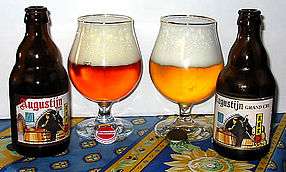
The designation "abbey beers" (Bières d'Abbaye or Abdijbier) originally applied to any monastic or monastic-style beer. After introduction of an official Trappist beer designation by the International Trappist Association in 1997, it came to mean products similar in style or presentation to monastic beers.[11] In other words, an Abbey beer may be:
- produced by a non-Trappist monastery — e.g. Benedictine; or
- produced by a commercial brewery under commercial arrangement with an extant monastery; or
- branded with the name of a defunct or fictitious abbey by a commercial brewer; or
- given a vaguely monastic branding, without mentioning a specific monastery, by a commercial brewer.
In 1999 the Union of Belgian Brewers introduced a "Certified Belgian Abbey Beer" (Erkend Belgisch Abdijbier) logo[12] to indicate beers brewed under license to an existing or abandoned abbey,[13] as opposed to other abbey-branded beers which the trade markets using other implied religious connections, such as a local saint.[14][15] The requirements for registration under the logo include the monastery having control over certain aspects of the commercial operation, and a proportion of profits going to the abbey or to its designated charities. Monastic orders other than the Trappists can be and are included in this arrangement.
What connoiseurs now recognize as Trappist breweries began operations in 1838. Several French monasteries, however, maintained "working" breweries for 500+ years before the French Revolution (1789–1799) disrupted religious life across the northern French province of Wallonia. Even then, some Abbey beers such as Affligem Abbey,[15] whose name now appears on beers made by the Heineken-owned Affligem Brewery,[16] resumed brewing from "working" monasteries until the occupation of most of Belgium in World War I. Commercial Abbey beers first appeared during Belgium's World War I recovery.
Although Abbey beers do not conform to rigid brewing styles, most tend to include the most recognizable and distinctive Trappist styles of brune (Belgian brown ale, aka dubbel), strong pale ale or tripel, and blonde ale or blond.[11][15] Modern abbey breweries range from microbreweries to international giants, but at least one beer writer warns against assuming that closeness of connection with a real monastery confirms a product's quality.[17]
As of 2011 eighteen certified Abbey beers[18] existed:
- Abbaye de Cambron, brewed in Silly by Brasserie de Silly.
- Abbaye de Bonne Espérance, previously brewed by Lefebvre Brewery, since 2015 more locally by La Binchoise.[19]
- Abdij Dendermonde, brewed in Merchtem by Brouwerij De Block
- Abbaye de Saint-Martin, historically referenced to 1096, is brewed near Tournai by Brasserie Brunehaut.
- Affligem, produced for Affligem Abbey by a Heineken-owned brewery.
- Brasserie de l'Abbaye du Val-Dieu is located on the grounds of a former abbey.
- Bornem is brewed in Oost-Vlaanderen by Brouwerij Van Steenberge
- Ename is brewed in Oost-Vlaanderen by Brouwerij Roman.
- Floreffe is brewed to fund a school housed in a former monastery.
- Grimbergen, made by the large Alken Maes brewery for an extant Norbertine abbey.
- Keizersberg is brewed in Oost-Vlaanderen by Brouwerij Van Steenberge.
- Leffe, the Abbey brand of Stella Artois, itself part of the multinational Inbev corporation, is brewed under licence from an extant brewery. It is thought to be the first such arrangement. Leffe has global distribution.
- Maredsous, the Abbey brand of Duvel Moortgat, Belgium's second largest brewer, licensed from Maredsous Abbey.
- Postel is brewed in Opwijk by Brouwerij De Smedt.
- Ramée is brewed in Purnode by Brasserie du Bocq.
- St. Feuillien is a small independent brewery.
- Steenbrugge is brewed in Brugge by Brouwerij De Gouden Boom.
- Tongerlo is brewed in Boortmeerbeek by Brouwerij Haacht.
Other non-certified Abbey beers include:-
- Abbaye des Rocs, made by a farmers' co-operative and named after a local ruined abbey.[20]
- Corsendonk, abbey beer brewed by a brewery in the name of the Corsendonk priory (monastery) in Oud-Turnhout
- Kasteelbier, monastic style beers brewed in a castle.
- St. Bernardus brewery, based on Watou originally brewed under contract for the abbey of St Sixtus at Westvleteren, but continues on an independent basis, in parallel with production at the monastery itself. Their range is considered a close match in recipe and style to the St Sixtus beers, which can be hard to obtain outside the area.
- Tripel Karmeliet, with a three-grain recipe, is produced by Bosteels Brewery, who also make Pauwel Kwak. Bosteels, and Tripel Karmeliet, are now part of AB InBev after a not-so-popular take-over in 2016.
Other Belgian beer types
Amber ales
These are beers similar to the traditional pale ales of England, although less bitterly hopped.[21] A notable example is the 5% abv De Koninck brand, with its distinctive spherical glasses (called 'bollekes'). It is popular in its native city of Antwerp. Another is Palm Speciale. Some, such as Vieux Temps, were based on British styles to please troops stationed in Belgium during World War I.[22] Others were introduced by the UK-born brewer George Maw Johnson in the late 19th century.[21] A very strong ambrée is brewed by "Bush" (Dubuisson), another brewery influenced by British styles.
Wallonian amber or ambrée ale, such a La Gauloise Ambrée, is considered to be somewhat distinct by some beer writers, and to be influenced by the French version of the ambrée style.[23]
Blonde or golden ale
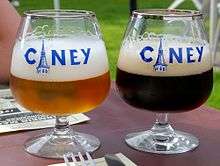

These are a light variation on pale ale, often made with pilsner malt.[17] Some beer writers regard blonde and golden ales as distinct styles, while others do not. Duvel is the archetypal Belgian blonde ale, and one of the most popular bottled beers in the country[24] as well as being well-known internationally.[25] Its name means "Devil" and some other blonde beers follow the theme—Satan, Lucifer and Judas for example. The style is popular with Wallonian brewers, the slightly hazy Moinette being the best-known example. Chouffe can be considered a spiced version (with coriander).
Brown ale
Regular bruin or brune beers such as Grottenbier are darker than amber ales, less sour than Flemish brown ale, and less strong than dubbel.
Champagne beers
Champagne style beers are generally ales that are finished "à la méthode originale" for champagne. Examples include Grottenbier, DeuS and Malheur Bière Brut. They receive a second fermentation much like Champagne does and are stored for several months "sûr lie" while the fermentation lasts. This creates the smaller, softer bubbles that we know from Champagne, but maintains the beer flavor and style.
Dubbel
Dubbel (double) has a characteristic brown colour. It is one of the classic Abbey/Trappist types, having been developed in the 19th century at the Trappist monastery in Westmalle. Today, some commercial brewers using abbey names call their strong brown beers "Dubbel". Typically, a dubbel is between 6 and 8% abv. In addition to the dubbels made by most Trappist breweries, examples include St. Bernardus Pater, Adelardus Dubbel, Maredsous 8 and Witkap Dubbel.
Dubbels are characteristically bottle conditioned.
Flemish Red
Typified by Rodenbach, the eponymous brand that started this type over a century ago, this beer's distinguishing features from a technical viewpoint are a specially roasted malt, fermentation by a mixture of several 'ordinary' top-fermenting yeasts and a lactobacillus culture (the same type of bacteria yoghurt is made with) and maturation in oak. The result is a mildly strong 'drinking' beer with a deep reddish-brown colour and a distinctly acidic, sour yet fruity and mouthy taste. This style is closely related to Oud bruin.
Hop-accentuated beers and India Pale Ale
A few Belgian beers are pale and assertively hopped. De Ranke's XX Bitter has a British-style name. Brouwerij Van Eecke's Poperings Hommelbier, another example, hails from Belgium's hop-growing district.
Lambic beers (including Gueuze and Fruit Lambics)
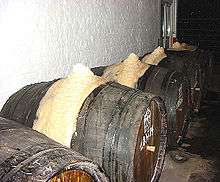
Lambic is a wheat beer brewed in the Pajottenland region of Belgium (southwest of Brussels) by spontaneous fermentation.[26] Most modern beers are fermented by carefully cultivated strains of brewer's yeasts; Lambic's fermentation, however, is produced by exposure to the wild yeasts and bacteria that are said to be native to the Senne valley, in which Brussels lies. The beer then undergoes a long aging period ranging from three to six months (considered "young") to two or three years for mature. It is this unusual process which gives the beer its distinctive flavour: dry, vinous, and cidery, with a slightly sour aftertaste.[27]
Lambic can be broken into three subclasses: Gueuze, Fruit Lambic, and Faro.
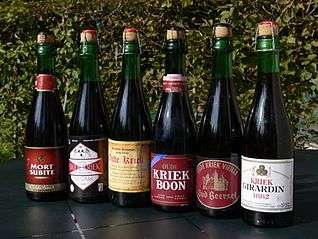
The first of these, gueuze, blends both old and young mixtures to stimulate a second fermentation. In its most natural form, Lambic is a draught beer which is rarely bottled, and thus only available in its area of production and a few cafes in and around Brussels. Fruit beers are made by adding fruit or fruit concentrate to Lambic beer. The most common type is Kriek, made with sour cherries. The last of the Lambic brews, Faro, is lambic with sugar or caramel added to prompt the fermentation.
Oud bruin, or Flemish sour brown ale
This style, aged in wooden casks, is a cousin to the sour "Flemish Red" style. Examples include Goudenband and Petrus.
Pils or pale lager
This style makes up the bulk of beer production and consumption in Belgium. Belgian Pilsners are not particularly distinctive or renowned by connoisseurs.[28][29][30] The top brands include Jupiler and Stella Artois (both brewed by Inbev), Maes pils and Cristal (both brewed by the Alken Maes branch of Heineken). Stella Artois, originating in Belgium, is distributed globally.
Saison
Saison (French, "season") is the name originally given to refreshing, low-alcohol pale ales brewed seasonally in farmhouses in Wallonia, the French-speaking region of Belgium, to refresh farm workers during harvest season. Modern-day saisons are also brewed in other countries, particularly USA, and are generally bottle conditioned, with an average range of 5 to 8% ABV,[31] though saisons at the more traditional 3.5% strength can still be found.
Although saison has been described as an endangered style,[32] there has been a rise in interest in this style in recent years, with Saison Dupont being named "the Best Beer in the World" by the magazine Men's Journal in July 2005.[33]
Historically, saisons did not share identifiable characteristics to pin them down as a style, but rather were a group of refreshing summer ales. Each farm brewer would make his own distinctive version.[34]
Scotch ales
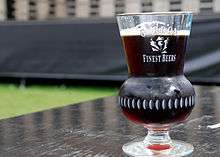
These sweet, heavy-bodied brown ales represent a style which originated in the British Isles. The Caledonian theme is usually heavily emphasized with tartan and thistles appearing on labels. Examples include Gordon's, Scotch de Silly and Achouffe McChouffe.
Stout
Belgian stouts subdivide into sweeter and drier, and stronger and weaker versions. Examples include Callewaerts and Ellezelloise Hercule. The sweeter versions resemble the almost-defunct British style "milk stout", while the stronger ones are sometimes described as Imperial stouts.[35]
Strong ale
Beers above 7%, such as tripels or strong dubbels, are referred to in some sources as Belgian strong ale,[36] although this is not a name used by Belgian brewers.[37]
Table beer
Table beer (tafelbier, bière de table) is a low-alcohol (typically not over 1.5%) brew sold in large bottles to be enjoyed with meals. The last decade it has gradually lost popularity due to the growing consumption of soft drinks and bottled water. It comes in blonde or brown versions. Table beer used to be served in school refectories until the 1980s; in the early 21st century, several organizations made proposals to reinstate this custom as the table beer is considered more healthy than soft drinks. Some bars serve a glass of draft lager with a small amount of table beer added, to take away the fizziness and act as a sweetener, in Limburg it is referred to as a "half om".[38][39]
Tripel
Tripel is a term used originally by brewers in the Low Countries to describe a strong pale ale, and became associated with Westmalle Tripel.[40] The style of Westmalle's Tripel and the name was widely copied by the breweries of Belgium,[41] then the term spread to the USA and other countries.[42] Gulden Draak was awarded the best-tasting beer in the world in 1998 by the American Tasting Institute (now ChefsBest).[43][44]
White or wheat beer
This type of beer, commonly called witbier in Dutch, bière blanche in French and wheat beer in English, originated in the Flemish part of Belgium in the Middle Ages. Traditionally, it is made with a mixture of wheat and barley. Before hops became widely available in Europe, beers were flavoured with a mixture of herbs called gruit. In the later years of the Middle Ages, hops were added to the gruit. That mixture continues today in most Belgian/Dutch white beers.
The production of this type of beer in Belgium had nearly ended by the late 1950s. In the town of Hoegaarden, the last witbier brewery, Tomsin, closed its doors in 1955. However, ten years later, a young farmer by the name of Pierre Celis in the same village decided to try reviving the beer. In 1966, Celis began brewing a wit beer in his farm house. Ultimately, his beer took the name of the village and became very successful and famous.
Some notable current examples are Celis White, Blanche de Namur and Watou's Wit. Their alcohol strength is about 5-6 percent ABV, and these beers can be quite refreshing, especially during the warm summer months. The herb mixture traditionally includes coriander and bitter orange peel,[45] among other herbs. White beers also have a moderate light grain sweetness from the wheat used. In recent times, brewers have been making fruit flavoured wheat beers.
Winter or Christmas beers
Many breweries produce special beers during December. Most contain more alcohol than the brewery's other types of beer and may also contain spicing. An annual beer festival in Essen near Antwerp focuses on this type of beer with over 190 beers available for tasting in 2014.[46]
Archaic styles
These include[47]
- Arge: A sour beer from Antwerp
- Faro: A beer that was drunk sweetened. Not necessarily the same as the modern Faro.
- Grisette ("little gray"): A lower-alcohol Saison drunk originally by miners in Hainault.[48]
- Happe: A predecessor of wheat beer, made with wheat and oats.
- Hoppe: An early hopped beer, from the mid-1500s when gruit was widely used.[49]
- Kuyte: also called Cuyte, a strong beer originating in 16th century France, as Quente, before becoming established in Belgium. Popular with the upper classes.[50]
- Pecce: A cheap beer.[51]
- Roedbier: Literally, red beer. It is not clear if this was a single style.
- Uitzet: A sour beer.
- Walgbaert or Waegebaert:[52] Similar to Happe.
- Zwaartbier: Literally, black beer. It is not clear whether this was a single style.
Glassware
Belgian "special" beers (stronger or bottled beers) are often served in elaborate branded beer glassware. Unless the bar is out of the specific glass that goes with that beer it is more often than not served in its own glass. Most bartenders or waitresses will apologize if the beer comes in a different glass.
One of the more common types is the tulip glass. A tulip glass not only helps trap the aroma, but also aids in maintaining large heads, creating a visual and olfactory sensation. The body is bulbous, but the top flares out to form a lip which helps head retention.
A vessel similar to a champagne flute is the preferred serving vessel for Belgian lambics and fruit beers. The narrow shape helps maintain carbonation, while providing a strong aromatic front. Flute glasses display the lively carbonation, sparkling color, and soft lacing of this distinct style.
Chalices and goblets are large, stemmed, bowl-shaped glasses mainly associated with Trappist and Abbey ales. The distinction between goblet and chalice is typically in the glass thickness. Goblets tend to be more delicate and thin, while the chalice is heavy and thick walled. Some chalices are even etched on the bottom to nucleate a stream of bubbles for maintaining a nice head.
In addition to the profusion of glasses provided by brewers, some Belgian beer cafés serve beer in their own "house" glassware. An example is La Lunette in Brussels.[53]
 Geuze lambic beer in a flute glass
Geuze lambic beer in a flute glass Orval beer in its "chalice" glass
Orval beer in its "chalice" glass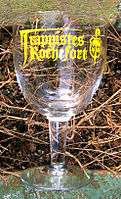 Rochefort beer in its "goblet" glass
Rochefort beer in its "goblet" glass- Duvel's tulip glass
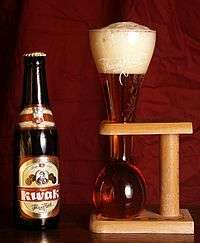 Kwak beer with its unusual glass and stand
Kwak beer with its unusual glass and stand- Hoegaarden Brewery wheat beer in its characteristic hexagonal glass
- Gilladeken, a Spéciale belge with bottle and glass
Distribution
The majority of Belgian beer brands are sold in bottles. Draught beers tend mostly to be pale lagers, wheat beers, regional favourites such as kriek in Brussels or De Koninck in Antwerp; and the occasional one-off. Customers who purchase a bottled beer (often called a "special" beer) can expect the beers to be served ceremoniously, often with a free snack.
These days, Belgian beers are sold in brown- (or sometimes dark green-) tinted glass bottles (to avoid negative effects of light on the beverage) and sealed with a cork, a metal crown cap, or sometimes both. Some beers are bottle conditioned, meaning reseeded with yeast so that an additional fermentation may take place. Different bottle sizes exist: 25 cl, 33 cl, 37.5 cl, 75 cl and multiples of 75. (8, 12, 24 or multiples of 24 fl. oz.) The 37.5 cl size is usually for lambics. Other beers are generally bottled in 25 or 33 cl format (depending on brands). The bigger bottles (75 cl) are sold almost in every food shop but customers do not always have an extensive choice. Bottles larger than 75 cl are named following the terminology used for champagne and are limited in quantity. In Belgian cafés, when someone orders a demi (English: "half"), he receives a 50 cl (half litre) glass (with beer from the tap, or from 2 bottles of 25 cl).
Virtually every Belgian beer has a branded glass imprinted with a logo or name.
Belgium contains thousands of cafés that offer a wide selection of beers, ranging from perhaps 10 (including bottles) in a neighbourhood café, to over 1000 in a specialist beer café. Among the most famous are "Beer Circus," "Chez Moeder Lambic," and "Delirium Café" in Brussels; "de Kulminator" and "Oud Arsenaal" in Antwerp, "De Garre" and "'t Brugs Beertje" in Bruges, "Het Botteltje" in Ostend, "Het Hemelrijk" in Hasselt, "Het Waterhuis aan de Bierkant", "De Dulle Griet" and "Trappistenhuis" in Ghent, "De Blauwe Kater" in Leuven, the Vaudrées in Liège and the "Stillen Genieter" in Mechelen. Although many major brands of beer are available at most supermarkets, off-licences located throughout the country generally offer a far wider selection, albeit at somewhat higher prices.
International distribution
Belgium exports 60% of its beer.[54] Some draught-beer brands produced by AB InBev - Stella Artois, Hoegaarden and Leffe - are available in several European countries. Aside from these, mostly bottled beer is exported across Europe. Cafés, exclusively or primarily offering Belgian beers, exist beyond Belgium in Australia, New Zealand, Canada, France, the United Kingdom and the United States, amongst others. Some beer festivals outside Belgium have a Belgian beer bar as an alternative to local products. In North America, a growing number of draught Belgian beer brands have started to become available, often at "Belgian Bars". Such brands include Brasserie Brunehaut, Karmeliet, Kwak, Maredsous, Mont Saint-Aubert, Palm, Rodenbach and St. Feuillien.
Beer festivals
Belgium has a number of beer festivals including:
- The BAB-bierfestival, held every year in February in Bruges[55]
- The festival held every spring in Leuven (previously in Sint Niklaas and Antwerp) organized by the consumer group Zythos.
- The Belgian Beer Weekend held in Grand Place, Brussels, organized by the Brewer's association.
- Karakterbieren Festival in Poperinge, Belgium's hop-growing capital.
- The Beer Passion weekend held each July in Antwerp, organized by Beer passion magazine,
- The Christmas beer festival Essen
- Alvinne Craft Beer Festival, at Picobrouwerij Alvinne, Zwevegem (Moen)
- "La Géroublonnade", beer and gourmet event in a village in Gérouville, region of southern Belgium, during second Sunday of July.
- The Weekend of Belgian Beers, held in Hasselt in November, organized by the Limburgse Biervrienden[56]
- The Weekend of Special Beer in Sohier in February - all informations : http://Www.sohier-village.be
Beer cuisine
A number of traditional Belgian dishes use beer as an ingredient. One is Carbonade (French: the Flemish term is stoverij or "stoofvlees"), a stew of beef cooked in beer, similar to Boeuf bourguignon. The beer used is typically the regional speciality — lambic in Brussels, De Koninck in Antwerp, and so on — so that the taste of the dish varies. Another is rabbit in gueuze. In't Spinnekopke, Brussels, and Den Dyver, Bruges are famed for their beer cookery. In 1998 Anheuser-Busch InBev started a worldwide chain of bars/restaurants, Belgian Beer Cafe, serving typical Belgian dishes combined with Belgian Beer.
The varied nature of Belgian beers makes it possible to match them against each course of a meal, for instance:
- Wheat beer with seafood or fish.
- Blond beers or tripel with chicken or white meat
- Dubbel or other dark beers with dark meat
- Fruit lambics with dessert
Appreciation and organizations
"Beer Passion" is a magazine, which also organizes a beer festival.[57] "Zythos" is the name of the main consumer's organization, successor to the earlier OBP (Objectieve Bierproevers).[58] The Belgian Brewers' Association[59] represents breweries. It organizes beer festivals and an open breweries day. The Knighthood of the Mashstaff honours individuals who have made an outstanding contribution to brewing, and pays tribute to Gambrinus and Saint Arnold.[60]
Beer writers who have written extensively on Belgian beer include Belgians Peter Crombeq, Gert van Lierde and Erik Verdonck, and Britons Michael Jackson and Tim Webb.
On December 1, 2016, in the eleventh session of the Intergovernmental Committee for the Safeguarding of the Intangible Cultural Heritage held in the United Nations Economic Commission for Africa Conference Centre, Addis Ababa, as an appreciation towards the beer culture in Belgium, it was inscribed on the Representative List of the Intangible Cultural Heritage of Humanity.
See also
References
- ↑ "500 nieuwe bieren in 4 jaar". Standaard.be. 2011-10-18. Retrieved 2013-09-18.
- ↑ "B.E.S (Belgian Label Service)". Users.telenet.be. Retrieved 2013-09-18.
- ↑ "Cheers as Belgian beer is added to Unesco cultural heritage list". The Guardian. 30 November 2016. Retrieved 15 June 2017.
- ↑ Decision of the Intergovernmental Committee: 11.COM 10.B.5, UNESCO, Intangible Cultural Heritage, accessed 15 June 2017.
- ↑ "Brewed force". The Economist. 17 December 2011. Retrieved 10 March 2013.
- ↑ Michael Jackson's Great Beers of Belgium, Michael Jackson, ISBN 0-7624-0403-5
- ↑ Jef van den Steen, Trappist - Het Bier en de Monniken ISBN 90-5826-214-6, page 33.
- ↑ P. De Commer: De brouwindustrie te Gent, 1505-1622. Handelingen der Maatschappij voor Geschiedenis en Oudheidkunde te Gent, 1983, 7, 113-171.
- ↑ Richard W. Unger (30 Mar 2007). Beer in the Middle Ages and the Renaissance. University of Pennsylvania Press. p. 187.
- ↑ "Tomp P Galvin on Orval". Tompgalvin.com. Retrieved 2013-09-18.
- 1 2 Ben McFarland (2009). World's Best Beers: One Thousand Craft Brews from Cask to Glass. Sterling Publishing Company, Inc. p. 38. ISBN 1-4027-6694-7. Retrieved 13 January 2011.
- ↑ Beer Paradise on "Recognised Abbey Beer" (Dutch Language) Archived 18 August 2007 at the Wayback Machine.
- ↑ "Beer made in Belgium: Abbey beer". beer.made.in. Archived from the original on 10 May 2008. Retrieved 13 January 2011.
- ↑ Adam Lindgreen; Joëlle Vanhamme; Michael B. Beverland (2009). Memorable Customer Experiences: A Research Anthology. Gower Publishing, Ltd. p. 77. ISBN 0-566-08868-1. Retrieved 13 January 2011.
- 1 2 3 "Michael Jackson's Beer Hunter - Belgium's Great Beers". Beerhunter.com. Retrieved 13 January 2011.
- ↑ "AFFLIGEM". Affligembeer.be. Retrieved 13 January 2011.
- 1 2 Tim Webb. Good Beer Guide to Belgium, 6th edition, p 81.
- ↑ (Dutch Language) List of Certified Abbey Beers
- ↑ "Abbaye de Bonne Espérance website". Retrieved 2017-06-20.
- ↑ "Belgian Beer Shrimper". Belgianbeershrimper.wordpress.com. 2010-01-10. Retrieved 2013-09-18.
- 1 2 Tim Webb. Good Beer Guide to Belgium, 6th edition, p 84.
- ↑ "Michael Jackson, Beer Hunter". Beerhunter.com. 1999-07-30. Retrieved 2013-09-18.
- ↑ Tim Webb. Good Beer Guide to Belgium, 6th edition, p 86.
- ↑ The Complete Handbook of Beers and Brewing Brian Glover
- ↑ "Belgian Brewer Finds Crafty Success". Wall Street Journal.
- ↑ "Lambicland - The World's Most Complex Beers and Simplest Cafes". booksaboutbeer.com. Archived from the original on 29 March 2008. Retrieved 30 June 2008.
- ↑ "Michael Jackson's Beer Hunter - Belgium's Great Beers". Beerhunter.com. Archived from the original on 17 July 2008. Retrieved 30 June 2008.
- ↑ Good Beer Guide to Belgium, 6th edition, p70, Tim Webb
- ↑ The Complete Handbook of Beers and Brewing p 124, Brian Glover.
- ↑ "The great beers of Belgium are not its lagers - Michael Jackson". Beerhunter.com. 1999-07-30. Retrieved 2013-09-18.
- ↑ "Michael Jackson's Beer Hunter - Beer Styles: Saison". Beerhunter.com. Archived from the original on 25 July 2008. Retrieved 6 July 2008.
- ↑ "Brasserie Dupont". www.belgianexperts.com. Archived from the original on 3 July 2008. Retrieved 6 July 2008.
- ↑ "MJ FEATURE: Best Beers in the World". www.mensjournal.com. Archived from the original on 7 July 2008. Retrieved 6 July 2008.
- ↑ Farmhouse Ales: Culture and Craftsmanship in the European Tradition, page 98, Phil Markowski, Brewers Publications (2004), ISBN 0-937381-84-5
- ↑ Tim Webb. Good Beer Guide to Belgium, 6th edition, p 90.
- ↑ Garret Oliver (9 Sep 2011). The Oxford Companion to Beer. Oxford University Press. p. 3.
- ↑ Tim Webb (29 May 2005). "A beer lover's guide to Brussels". The Observer.
- ↑ Guardian article retrieved 27 March 2007
- ↑ Dutch article retrieved 27 March 2007
- ↑ "Michael Jackson's Beer Hunter - Beer Styles: Tripel". Beerhunter.com. Retrieved 11 July 2009.
- ↑ The Great Beers of Belgium, Michael Jackson, MMC, 1997, page 226
- ↑ Belgian Ale, Pierre Rajotte, Brewers publications, 1992, pages 31-34
- ↑ (in Dutch) Van Steenberge Brewery - Gulden Draak
- ↑ "Michael Jackson's Beer Hunter - Down on your knees to bless monks' top ale". Beerhunter.com. Retrieved 11 July 2009.
- ↑ "ingredients". Hoegaarden. Retrieved 2013-09-18.
- ↑ Essen Christmas Beer Festival List retrieved 16 June 2015
- ↑ "James Mew: ''Drinks of the World'', 1892". Chestofbooks.com. Retrieved 2013-09-18.
- ↑ Alworth, Jeff (2011-07-25). "A US microbrerwey recreates Grisette". Beervana.blogspot.co.uk. Retrieved 2013-09-18.
- ↑ "Alexandre HENNE et Alphonse WAUTERS, Histoire de la ville de Bruxelles, quoted on Hombrewtalk.com". Homebrewtalk.com. Retrieved 2013-09-18.
- ↑ A History of Food, Maguelonne Toussaint-Samat, retrieved from google books. Books.google.co.uk. 2009-03-25. Retrieved 2013-09-18.
- ↑ "Beverages Past and Present. E.R Emerson, 1856". Archive.org. Retrieved 2013-09-18.
- ↑ "The Fran Book brewery". Tiac.net. 1995-08-16. Retrieved 2013-09-18.
- ↑ Belgium (2007-05-19). "Trip Advisor on La Lunette". Travbuddy.com. Retrieved 2013-09-18.
- ↑ Good Beer Guide to Belgium 6th Edition, Tim Webb
- ↑ "Home - Bierfestival Brugge / Bruges Beer Festival / Februari 2013". Brugsbierfestival.be. Retrieved 2013-09-18.
- ↑ "Die Limburgse Biervrienden 2014". limburgse-biervrienden.be. 2013-06-23. Retrieved 2013-09-18.
- ↑ "Beer Passion". Beer Passion. Retrieved 2013-09-18.
- ↑ John White of White Beer Travels. "White's Beer Travels on the OBP, DOB and Zythos". Whitebeertravels.co.uk. Retrieved 2013-09-18.
- ↑ "beerparadise.be". beerparadise.be. 2013-09-08. Retrieved 2013-09-18.
- ↑ John White of White Beer Travels. "The Knighthood of the Mashstaff". Whitebeertravels.co.uk. Retrieved 2013-09-18.
- Bibliography
- Good Beer Guide to Belgium, Tim Webb, CAMRA Books, ISBN 1-85249-210-4
- Farmhouse Ales: Culture and Craftsmanship in the Belgian Tradition, Phil Marowski, Brewers Publications (2004), ISBN 0-937381-84-5
- Great Beers of Belgium, Michael Jackson, ISBN 90-5373-012-5
- Lambicland: Lambikland, Tim Webb, Chris Pollard, Joris Pattyn, Cogan and Mater Ltd, ISBN 0-9547789-0-1
External links
| Wikimedia Commons has media related to Beers of Belgium. |
- All About Belgian Beer in English Language
- Belgium's Great Beers
- Belgian Beer Map - Distribution of Belgian breweries by provinces
- All About Belgian Beer and Beer Tourism in Belgium (in English) from BeerTourism.com
- Brewers in Belgium at DMOZ
